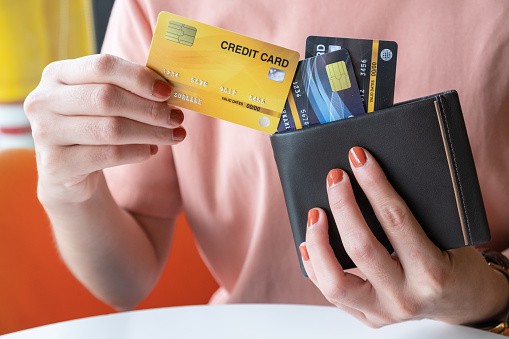Borrowing money is so much easier than repaying it. And if you’re like the typical American, you owe a lot of money.
In 2018, the average American was coping with $38,000 in personal debt, excluding home mortgages, according to Northwestern Mutual’s Planning & Progress Study. When income is limited and expenses are high, you might wonder whether it’s possible to pay off all your debt and not just the minimum payments. Thankfully, it is possible in most cases.
“Facing your debt demons is often the hardest part,” says credit expert Sally Herigstad, author of “Help! I Can’t Pay My Bills.” “It’s like stepping on the scale after Christmas. Sure, you’re scared to see what you’ve done, but it’s better to know what the situation is so you can do something about it.”
Here’s how seven people confronted their debts and climbed out of their financial hole — and how you can follow their lead.
Accepting a Challenge
Jessica Garbarino, who lives in Indian Land, South Carolina, wiped out $56,000 in debt ($29,000 in student loans, $14,000 in credit card bills, and a $13,000 car loan) but she did it in fits and starts.
“My story is a reality check in how debt payoff may not happen as fast … as you want it to be,” Garbarino says. “The first year I paid off $26,000 of the initial debt. Then life happened. I moved 1,700 miles away to help take care of my grandparents, lost my job and went through foreclosure. For two years, I stopped the aggressive debt payoff mode but didn’t go into more debt.”
The setback was only temporary. Garbarino got back in the game when a friend posted a challenge on Facebook about what people wanted to accomplish in five years.
“I knew I had to finish paying off my debt,” says Garbarino, who accepted the challenge and jumped into repayment mode.
She sent the last monthly payment to her creditors in March 2015. And she remains on solid financial ground.
“It took a lot of focus, re-focus, and determination to make my debt-free goal a reality,” Garbarino says, “but it was totally worth the sacrifice.”
Going to Debt-Reduction School
Kara Duffy and her boyfriend enrolled in Dave Ramsey’s Financial Peace University course in 2016, and it changed their lives. The Costa Mesa, California, couple erased $86,000 in credit card debt in an astonishing six months by adopting the core principles of the course.
“First, we got real about how much money was coming in, what we’re spending and where,” Duffy says.
Then, they developed a lean but smart budget that allowed them to live well enough without existing on a ramen-only diet.
Cutting up their credit cards came next. Adhering to the Ramsey approach, they created a “debt snowball” plan by ranking their debts from the highest to lowest balances, then devoting the most amount of money to the smallest obligation while the others got the minimum.
“Once the first debt was paid off, we carried over the $125 we were paying on the first debt to the second debt,” Duffy says. “We kept our total debt budget the same each month until all the debt was paid off.”
The appeal of the “snowball” method, Duffy says, is watching the account balances reduce, enabling you to celebrate quick victories and maintain momentum.
Relying on the ‘Cash Envelope Budget System’
David Pipp and his wife, Cassie, run the personal finance blog Living Low Key from their home in Santa Rosa, California.
They started the blog to share their journey about digging out of a car loan debt that totaled $30,000 while also saving for retirement. The couple amassed the debt when they were in their early 20s, surviving on his enlisted-military salary of less than $40,000 a year. With bills mounting, they decided to make some changes.
“We were sick of struggling to pay the bills and worrying about money, so we decided to start using the cash envelope budget system to manage our money and pay off debt,” David Pipp says.
This strategy consists of creating several budget categories and putting a certain amount of cash in an envelope designated for each category. For example, you might stick $300 in the grocery envelope, $50 in the entertainment envelope and so forth.
When an envelope is empty, you don’t replenish the cash until the start of the next pay period or next month.
“By being frugal, cutting our expenses to the bare minimum and living well below our means, we were able to pay off debt crazy fast,” Pipp says.
In two years, the Pipps became debt-free. And they wound up with a six-figure retirement account in five years. The pair continues to use the cash envelope budget system to manage their finances, and they’ve steered clear of overborrowing.
Taking Interest in Interest Rates
Michael Bolls of Chicago paid off $18,000 in car, student, and credit card debt within three years of earning his college diploma. He did it by focusing on interest rates and investing his student loans.
Bolls paid the bare minimum on debts with the lower rates and the most on his credit card balances, which carried interest rates of up to 25%. Meanwhile, he was profiting by investing the student loan money he received into index funds, which are a kind of mutual fund where the portfolio matches an index, such as the S&P 500. It buys the same stocks listed in that index, so the management costs are reduced. He then used the proceeds to pay college expenses.
“Some debts grow slower than what is offered by low-cost index funds,” says Bolls, who deposited his student loan money into those funds. The earnings outpaced the cost of the loans.
“With a gain of around 6% to 23% every year, I was getting free money while I went to school,” Bolls says.
It was an effective get-out-of-debt and money-making system. Today, he always pays off accounts with high-interest rates ahead of schedule.
“Letting any of these debts grow is a total nightmare,” Bolls says. “The debt on a credit card with a 25% APR can double within three years.”
Slashing the Budget
When Tucson, Arizona resident Marissa Sanders was grappling with $26,000 worth of debt from a mixture of credit cards, student loans, an auto loan, and medical bills, she was struggling to make ends meet. Sanders decided to become debt-free after being unable to buy groceries for her family. With one young child at home and pregnant with another, she had to take swift action.
“The first thing I did was to save for a small emergency, which for me was $1,000,” Sanders says.
She then tackled her debt
“I dedicated myself to truly living within my means and downsizing my lifestyle to match what I was earning at the time,” Sanders says. “I did not do anything crazy, like selling a car, sell my house, move, or [depend on] my home equity or retirement. I simply lived within my means, created a perfect budget and learned various ways to save money.”
She earmarked the money she wasn’t spending to eliminate her debt in two years, a feat she writes about on her personal finance blog, Simple Money Mom.
Getting Creative
In just one year, Lou Haverty of Philadelphia banished $6,000 in debt by embracing a variety of creative approaches.
He accumulated the debt during his first year out of college, relying on credit cards to bridge the gap between paychecks and bills. The credit card balances grew slowly but eventually reached an uncomfortable level.
“I was close to my combined credit limit on my two credit cards,” Haverty says.
Since he wasn’t making much money at his first post-college job, he had to be inventive. Haverty negotiated with the cable company to lower his monthly bills, learned how to cook to skip costly restaurant meals, sold unwanted items on eBay and picked up a part-time bartending job on the weekends.
“The experience turned out to be good in the long run because it taught me how to budget, but it also made me realize I needed to find a longer-term plan to earn more money,” Haverty says.
So not only did he pay off his debt quickly, but he pursued a CFA (certified financial adviser) designation and now enjoys a more lucrative career in corporate banking.
Moving Out and Moving On
After Kelly Hayes-Raitt’s political consulting business took a nosedive, she ran up $90,000 in credit card debt in a single year. She had been using her credit cards to cover her employees’ salaries for longer than was feasible.
At first, she tried to juggle the debt by shifting the higher-interest balances to 0% intro APR balance transfer cards. That worked for a time, but the option soon fizzled out.
So in 2008, Hayes-Raitt did something drastic: She moved out of her own home and rented it out. Then she became a house and pet sitter, taking jobs that offered places to live while the homeowners were away. The money poured in, and Hayes-Raitt paid off the last of her credit card debt in April 2010.
“Except for my mortgage, I am now entirely debt-free,” she says. “However, I decided I liked the housesitting lifestyle so much, I’ve continued and have now been traveling full time for 10 years.”
This lifestyle has taken her to London; Paris; Amsterdam; Berlin; Gibraltar; Africa; Kuala Lumpur; Hanoi, the capital of Vietnam; Osaka, the third-largest city in Japan; and Ya’an, a city in China’s Sichuan province. She chronicles her travels in the book “How to Become a Housesitter: Insider Tips from the HouseSit Diva.”
How Can You Reduce Your Debt?
Whichever debt payoff method speaks to you, the crucial part is maintaining your strategy over the long term. You’ve got to keep the faith that you can reach the end, says financial planner Scott Alan Turner, author of “99 Minute Millionaire, Money A to Z.”
To stay inspired, Turner suggests surrounding yourself with people, books, shows or anything else that motivates you to remain on track.
“There are entire communities of people just like you,” Turner says. “They have achieved the same goals, beaten down debt and are financially free. They love cheering other people on to do the same.”
Herigstad, the credit expert, recommends looking inward in your trek toward freedom from debt.
“Adopting a can-do attitude is so important,” Herigstad says. “As long as you’re still healthy enough, you can slay debt. People do it all the time. It’s inspiring to read about other people’s successes, but also look at your own. Maybe you’ve raised children by yourself or quit smoking. Those are difficult things, so if you did them, you can do this.”



